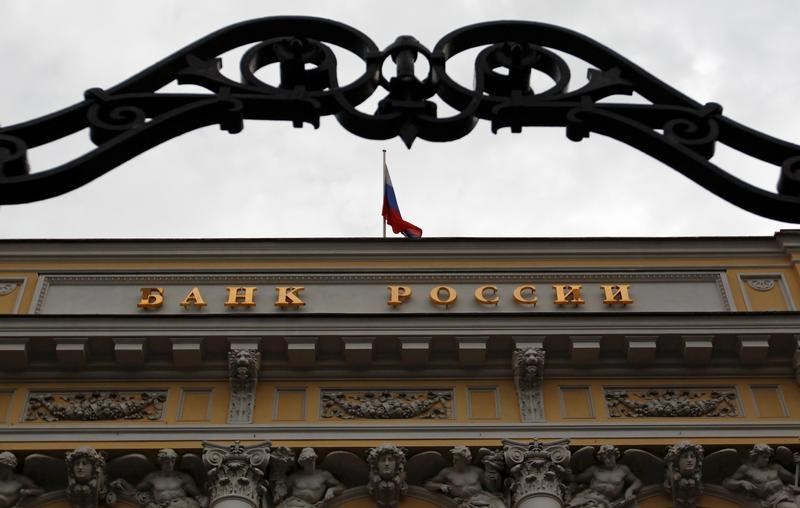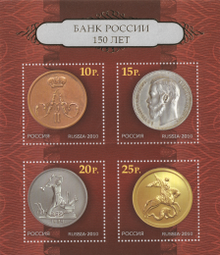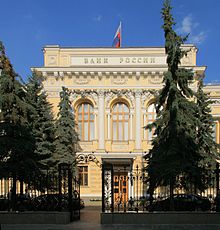bail-in
Владельцы облигаций «Пересвета», которые голосовали против их конвертации в капитал, получат вложенные деньги. Для не согласных с принятым решением миноритариев готовятся особые условия.
Держатели трех выпусков облигаций «Пересвета», не согласившиеся на конвертацию облигаций в рамках bail-in, получат денежные выплаты в размере 100% от номинала, сказал журналистам первый зампред ЦБ Сергей Швецов в кулуарах ПМЭФ.
«Те, кто не участвовал в bail-in, получат полностью свои денежные средства», — заявил Сергей Швецов в ответ на вопрос о том, что будет с держателями бумаг «Пересвета», не попавших в конвертацию. Иными словами, эти облигационеры оказались в более выгодном положении, чем минотарии и те, кто проголосовал за конвертацию, признал он.
Условия bail-in для миноритариев, которые были вынуждены согласиться с решением держателей крупной доли, могут быть изменены, сообщил Швецов. «Насколько я знаю, финансовый агент, который проводил конвертацию, готовит для этих облигационеров предложения, чтобы у них были условия не хуже, чем у остальных участников bail-in», — добавил он.
Держатели облигаций, проголосовавшие за введение bail-in, получили 15% в виде денежных выплат, а остальные 85% средств были переведены в капитал банка. При этом миноритарии, голосовавшие против, были вынуждены подчиниться решению держателей крупных пакетов на тех же условиях.
О конвертации облигаций «Пересвета» в капитал Банк России объявил 19 апреля. В ходе процедуры bail-in обязательства банка перед держателями облигаций переводятся в более длинный долг и под более низкий процент. В случае с «Пересветом» за введение bail-in должны были отдельно проголосовать держатели каждого выпуска бумаг. Положительное решение принималось в том случае, если держатели большей части выпуска (50% плюс одна акция) голосовали за конвертацию. Владельцы небольших пакетов при этом вынуждены были подчиняться решению большинства.
В такой ситуации оказались миноритарии шести выпусков облигаций «Пересвета». Держатели трех выпусков проголосовали против bail-in.
www.rbc.ru/finances/02/06/2017/5931b40b9a7947af1e2573a1
ЦБ РФ детально изучить плюсы и минусы механизма bail-in От IFX
 © Reuters. ЦБ РФ детально изучить плюсы и минусы механизма bail-in
© Reuters. ЦБ РФ детально изучить плюсы и минусы механизма bail-in ЦБ РФ намерен детально изучить плюсы и минусы механизма bail-in, заявила глава Банка России Эльвира Набиуллина журналистам в кулуарах финансовой «Двадцатки» в Китае. Однако, добавила она, это не тема ближайшего года.
Bail-in — это принудительная конвертация требований кредиторов в субординированные займы или уставный капитал для покрытия «дыры» в капитале банка.
Российские власти с конца 2015 года обсуждали введение в РФ bail-in как одного из вариантов работы с банками, оказавшимися на грани банкротства. В июне ЦБ РФ объявил о планах изменить процедуру спасения банков, новые проекты санации предлагается поручить специальному фонду консолидации банковского сектора.
«Тема bail-in обсуждается отдельно от фонда консолидации банков и, на мой взгляд, она еще будет некоторое время обсуждаться, потому что, несмотря на то, что есть очевидные плюсы у такой потенциальной системы, есть и опасения. Мы видим, как нелегко начинает работать эта система в ЕС, в том числе много дискуссий о потенциальной эффективности применения bail-in в отношении итальянских банков», — отметила Э.Набиуллина.
«Мы будем обсуждать с учетом того, что эта система должна не снижать, а укреплять доверие граждан и бизнеса к банковской системе. Поэтому, на мой взгляд, эта тема во всяком случае не ближайших нескольких месяцев и даже, может быть, не ближайшего года. Я думаю, что ближайший год, скорее всего, это будет период обсуждения», — сказала она, добавив, что у ЦБ нет конкретных графиков введения bail-in в РФ.
Вместе с тем, она указала на очевидный плюс bail-in: этот механизм во многих случаях позволяет сохранять банку лицензию.
Предупреждение: Fusion Media would like to remind you that the data contained in this website is not necessarily real-time nor accurate. All CFDs (stocks, indexes, futures) and Forex prices are not provided by exchanges but rather by market makers, and so prices may not be accurate and may differ from the actual market price, meaning prices are indicative and not appropriate for trading purposes. Therefore Fusion Media doesn`t bear any responsibility for any trading losses you might incur as a result of using this data.ЦБ РФ детально изучить плюсы и минусы механизма bail-in От IFX
 © Reuters. ЦБ РФ детально изучить плюсы и минусы механизма bail-in
© Reuters. ЦБ РФ детально изучить плюсы и минусы механизма bail-in Bail-in — это принудительная конвертация требований кредиторов в субординированные займы или уставный капитал для покрытия «дыры» в капитале банка.
Российские власти с конца 2015 года обсуждали введение в РФ bail-in как одного из вариантов работы с банками, оказавшимися на грани банкротства. В июне ЦБ РФ объявил о планах изменить процедуру спасения банков, новые проекты санации предлагается поручить специальному фонду консолидации банковского сектора.
«Тема bail-in обсуждается отдельно от фонда консолидации банков и, на мой взгляд, она еще будет некоторое время обсуждаться, потому что, несмотря на то, что есть очевидные плюсы у такой потенциальной системы, есть и опасения. Мы видим, как нелегко начинает работать эта система в ЕС, в том числе много дискуссий о потенциальной эффективности применения bail-in в отношении итальянских банков», — отметила Э.Набиуллина.
«Мы будем обсуждать с учетом того, что эта система должна не снижать, а укреплять доверие граждан и бизнеса к банковской системе. Поэтому, на мой взгляд, эта тема во всяком случае не ближайших нескольких месяцев и даже, может быть, не ближайшего года. Я думаю, что ближайший год, скорее всего, это будет период обсуждения», — сказала она, добавив, что у ЦБ нет конкретных графиков введения bail-in в РФ.
Вместе с тем, она указала на очевидный плюс bail-in: этот механизм во многих случаях позволяет сохранять банку лицензию.
Предупреждение: Fusion Media would like to remind you that the data contained in this website is not necessarily real-time nor accurate. All CFDs (stocks, indexes, futures) and Forex prices are not provided by exchanges but rather by market makers, and so prices may not be accurate and may differ from the actual market price, meaning prices are indicative and not appropriate for trading purposes. Therefore Fusion Media doesn`t bear any responsibility for any trading losses you might incur as a result of using this data.Central Bank of Russia — Wikipedia
The Central Bank of the Russian Federation (Russian: Центральный банк Российской Федерации Tsentral’nyy bank Rossiyskoy Federatsii) also known as the Bank of Russia (Russian: Банк России Bank Rossii) is the central bank of the Russian Federation, founded in 1860 as The State Bank of the Russian Empire,
History[edit]
 Russian postage stamp sheet in commemoration of 150-year anniversary of setting up of Bank of Russia.
Russian postage stamp sheet in commemoration of 150-year anniversary of setting up of Bank of Russia.  Bank of Russia headquarters in Moscow
Bank of Russia headquarters in MoscowState Bank of the Russian Empire[edit]
GosBank headquarters in Saint Petersburg (1905)In early 1917 the bank had eleven branches, 133 permanent and five temporary offices and 42 agencies. On 7 November 1917 the Russian State Bank was disestablished and replaced by The People’s Bank which existed until the establishment of the Soviet Gosbank.
State Bank of the Soviet Union[edit]
The Central Bank of the Russian Federation[edit]
The Central Bank of the Russian Federation (Bank of Russia) was established 13 July 1990 as a result of the transformation of the Russian Republican Bank of the State Bank of the USSR. It was accountable to the Supreme Soviet of the RSFSR. On 2 December 1990 the Supreme Soviet of the RSFSR passed the Law on the Central Bank of the Russian Federation (Bank of Russia), according to which the Bank of Russia has become a legal entity, the main bank of the RSFSR and was accountable to the Supreme Soviet of the RSFSR. In June 1991, the charter was adopted by the Bank of Russia. On 20 December 1991 the State Bank of the USSR was abolished and all its assets, liabilities and property in the RSFSR were transferred to the Central Bank of the Russian Federation (Bank of Russia), which was then renamed to the Central Bank of the Russian Federation (Bank of Russia). Since 1992, the Bank of Russia began to buy and sell foreign currency on the foreign exchange market created by it, establish and publish the official exchange rates of foreign currencies against the ruble.
Role and duties[edit]
According to the constitution, it is an independent entity, with the primary responsibility of protecting the stability of the national currency, the ruble.[5]
Before 1 September 2013, it was the main regulator of the Russian banking industry, responsible for banking licenses, rules of banking operations and accounting standards, serving as a lender of last resort for credit organizations. After pointed date functions and powers of CBR were significantly expanded and the central bank received the status of a mega-regulator of all financial markets of Russia.
It holds the exclusive right to issue ruble banknotes and coins through the Moscow and St. Petersburg mints, the Goznak mint.[citation needed] The central bank issues commemorative coins made of precious and non-precious metals as well as investment ones made of precious metals, which are distributed inside and outside the country.[7] In 2010 in honor of its 150th anniversary it issued a 5-kilo commemorative gold coin Alexander II.[8]
Under Russian law, half of the bank’s profit must be channeled into the government’s federal budget. The Central Bank of Russia is a member of the BIS.[9]
The Bank of Russia owns a 57.58% stake in Sberbank, the country’s leading commercial bank. The Bank of Russia owns as well 100% stake in Russian National Reinsurance Company (RNRC), biggest national reinsurance company. RNRC was established for prevention possible problems with abroad reinsurance of large risks under International sanctions during the Ukrainian crisis, like constructing the Crimean Bridge.[10]
Anti-fraud activities[edit]
In 2017, within the framework of a joint anti-phishing project of the Bank of Russia and search engine Yandex, a special check mark (a green circle with a tick and ‘Реестр ЦБ РФ’ (Bank of Russia Register) text box) appeared in the search results, informing the consumer that the website is really owned by a legally registered company licensed by the Bank of Russia.[11][12]
Chairmen[edit]
Governors of the State Bank[edit]
The governor was appointed by the emperor of Russia.
Chairman of the board of the USSR State Bank[edit]
The chairman was appointed by the Premier of the Soviet Union.
President of the Central Bank of Russia[edit]
The President of the Board of Directors of the Central Bank is the head of the central banking system of the Russian Federation. The Head is chosen by the President of Russia; and serves for four-year-terms after appointment. A Head may be appointed for several consecutive terms (Sergey Ignatyev was the Governor of the Central Bank for 11 years, and he was appointed three times, in the longest serving term in post-soviet Russia).
Subsidiaries[edit]
The Central Bank of Russia holds directly significant participatory interests in a number of Russian companies:
Additionally, the Bank of Russia held earlier interests in some other Russian organizations. In particular, after the liquidation of Gosbank (State Bank of the USSR), the CBR beneficially acquired complete or controlling interests in five so-called «Russian Foreign Banks» (until 1991 – «Soviet Foreign Banks»):
All of them were members of the USSR Vneshekonombank system and were transferred to the CBR in 1992 by the Resolution of the Presidium of the Supreme Soviet of Russia. For over five years – 2000 to 2005 – all stocks of the Russian Foreign Banks were being purchased from the Bank of Russia by VTB Bank. As part of the financial support to credit institutions, the Bank of Russia invests in them through the Banking Sector Consolidation Fund and acquires (on a temporary and indirect basis) shares in the equity of such banks. The first project of this kind was Otkritie FC Bank, in summer 2017.
Politics[edit]
In December 2014, amidst falling global oil prices, Western sanctions over the Ukraine crisis, capital flight, and fears of recession, the bank had increased the one-week minimum auction repo rate up by 6.5 points to 17 percent. This caused a run on the ruble, and on 29 January, the bank decreased the rate by two points to 15 percent.
In January 2015, the head of monetary policy, Ksenia Yudayeva, a proponent of strict anti-inflation policy, was replaced by Dmitry Tulin, who is «seen as more acceptable to bankers, who have called for lower interest rates».[14]
See also[edit]
References[edit]
- ^ History of the Bank of Russia. 1860–2010. In 2 vols. Ed.: Y. A. Petrov, S. Tatarinov. 2010.
- ^ CBR. «Bank of Russia Today:History».
- ^ «Рейтинг банков | Банки.ру». Banki.ru. Retrieved 3 January 2020.
- ^ Об учреждении Государственного банка [On the establishment of the State Bank] (in Russian). XV, 1758—1762 , № 11550 (Полное собрание законов Российской империи [ru] с 1649 года ed.). СПб.: Типография II отделения Собственной Его Императорского Величества канцелярии. 1830: 1021–1023.
- ^ Bank of Russia:Banking Legislation
- ^ «Elvira Nabiullina: Establishing a mega regulator for the Russian financial sector», Bank for International Settlements : Central bankers’ speeches : Speech by Ms Elvira Nabiullina, Governor of the Bank of Russia, at the Federation Council, Moscow, 15 February 2017
- ^ «Commemorative Coins – Banknotes and Coins – Bank of Russia». cbr.ru.
- ^ «Russia to issue 5 kg gold coin» Archived 23 May 2010 at the Wayback Machine, The Financial Express. 19 May 2010. Accessed 19 May 2010.
- ^ «Inside the Risky Bets of Central Banks», The Wall-Street Journal. 12 December 2012
- ^ «Putin signed a law establishing a National reinsurance company», World News, Breaking News, 4 July 2016
- ^ «Bank of Russia to mark microfinance organisations on the Internet | Банк России». www.cbr.ru. Retrieved 16 August 2017.
- ^ «Insurers’ websites receive first marks | Банк России». www.cbr.ru
 |
| |||||||||||||||||||||||||||||
|  |
| ||||||||||||||||||||||||||||
|  | 
| ||||||||||||||||||||||||||||

